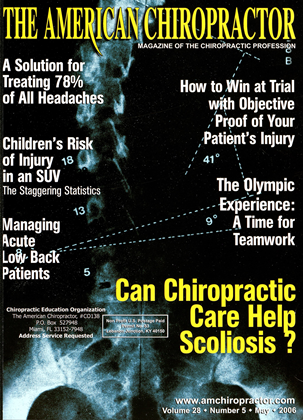I just finished reading the article by Dr. Koren regarding The Upper Thoracic Hump Pattern and fixing it with Koren Specific Technique (March 2006). Dr. Koren has fallen into the quagmire of thinking that a chiropractic subluxation can cause this posture profile, and that an adjustment can fix it. The reality of the situation is not that simplistic. This type of posture profile is created from a long-term process involving the entire kinetic chain and, more importantly, involves physiological changes in muscles that cannot possibly be reversed by an adjustment. To create the posture pattern Dr. Koren describes, three major spine/pelvis compensations must occur. 1. Head moves forward of the shoulders (FHP). 2. To counter-balance, the upper back drifts backward. 3. As a third counter-balance, the pelvis tilts forward. All three contribute to the Hump Pattern and all three must be addressed for real permanent change to occur. In addition, with an FHP severe enough to cause the hump, there will be internal rotation of the shoulder joint and all the muscle changes involved with that. The muscles attached to the spine, as all other striated muscles in the body, are affected by certain physiological laws that don't magically disappear when an adjustment is delivered. In the Forward Head Posture profile, we know which muscles are being stretched and which are being held in a shortened position. These groups of muscles "lock" into these positions, if held for long periods of time, as in the FHP profile. In both cases, short and long, the muscles become weak and inefficient, causing other muscles to be recruited, and causing shear forces to be created at the joints that will eventually result in joint instability. While there may certainly be a chiropractic subluxation component to this condition, it's not the usual cause, or the path for correction. And, while normal motion must be maintained in the spinal joints, specific attention to the muscles is the key to permanent correction. There will also be involvement in the transverse abdom, and the psoas, and others. Any program that hopes to correct the Hump Pattern, MUST include specific stretches to lengthen short muscles and strengthen stretched muscles. These will pull the head back, reposition the upper back and allow the pelvis to return to a normal position. I respect Dr. Koren's contributions to the profession and his passion as a true chiropractic warrior. His observations regarding the Hump Pattern, in my opinion, are simplistic and incomplete and provide false hope for both doctor and patient. 1 would love to see a few sets of pre and post images. Having a few in the article would have helped. I will use my Posture Pro software to analyze pre, post and final photographs. There will be a sincere apology should the results follow the claims. Joseph Ventura, D.C. www.poslurepro.com info@posturepro. com
 View Full Issue
View Full Issue






